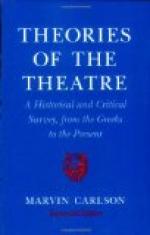But not only in the details of a drama is the use of climax necessary. The whole action should sweep upward in intensity until the highest point is reached. In the Shakespearean drama the highest point came somewhat early in the piece, usually in the third act of the five that Shakespeare wrote; but in contemporary plays the climax is almost always placed at the end of the penultimate act,—the fourth act if there are five, and the third act if there are four. Nowadays the four-act form with a strong climax at the end of the third act seems to be most often used. This is the form, for instance, of Ibsen’s Hedda Gabler, of Mr. Jones’s Mrs. Dane’s Defense, and of Sir Arthur Pinero’s The Second Mrs. Tanqueray, The Notorious Mrs. Ebbsmith, and The Gay Lord Quex. Each begins with an act of exposition, followed by an act of rising interest. Then the whole action of the play rushes upward toward the curtain-fall of the third act, after which an act is used to bring the play to a terrible or a happy conclusion.
A less familiar means of emphasis is that which owes its origin to surprise. This expedient must be used with great delicacy, because a sudden and startling shock of surprise is likely to diseconomise the attention of the spectators and flurry them out of a sane conception of the scene. But if a moment of surprise has been carefully led up to by anticipatory suggestion, it may be used to throw into sharp and sudden relief an important point in the play. No one knows that Cyrano de Bergerac is on the stage until he rises in the midst of the crowd in the Hotel de Bourgogne and shakes his cane at Montfleury. When Sir Herbert Tree played D’Artagnan in The Musketeers, he emerged suddenly in the midst of a scene from a suit of old armor standing monumental at the back of the stage,—a deus ex machina to dominate the situation. American playgoers will remember the disguise of Sherlock Holmes in the last act of Mr. Gillette’s admirable melodrama. The appearance of the ghost in the closet scene of Hamlet is made emphatic by its unexpectedness.




